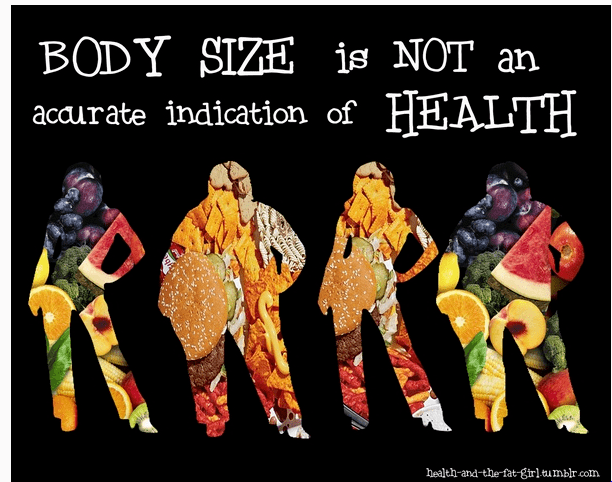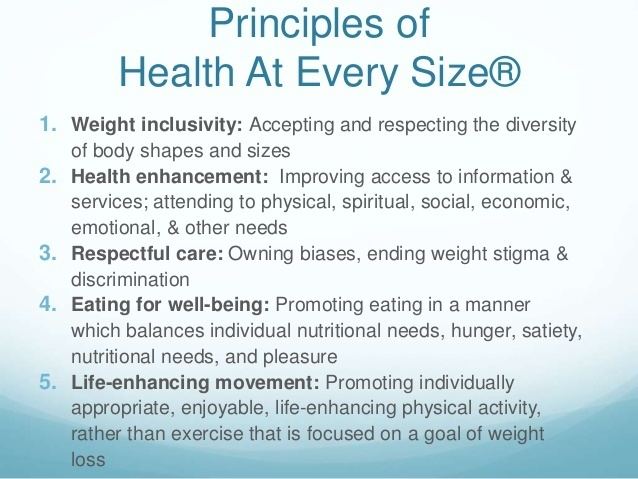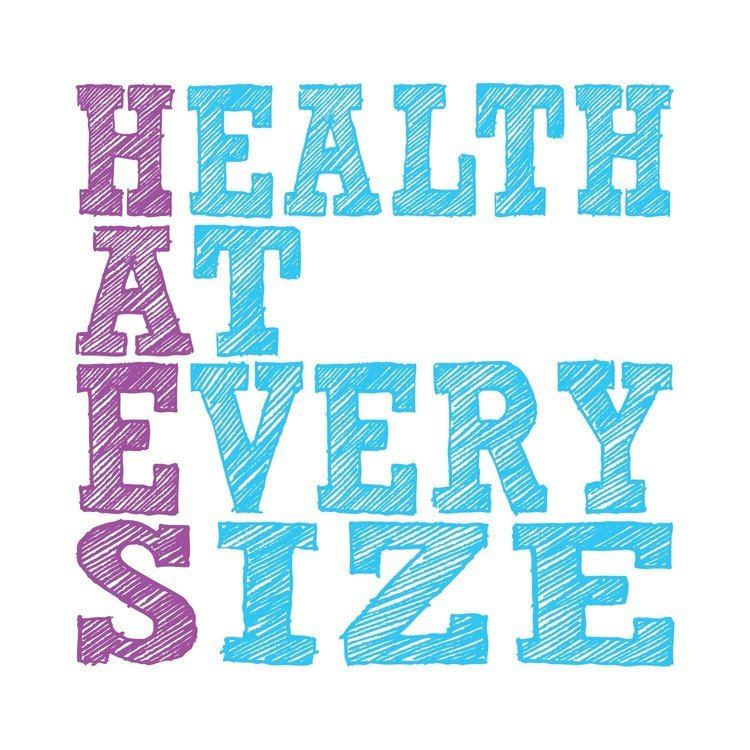 | ||
Health at Every Size (HAES) is a movement that claims to "support people in adopting health habits for the sake of health and well-being (rather than weight control)." Proponents aim to improve the standard of living for people who are overweight or obese by promoting healthy lifestyles and anti-discrimination efforts. Generally, these efforts do not include weight loss as a direct goal.
Contents

HAES advocates reject the idea that dieting with the goal of weight loss directly and controllably improves health. The benefits of lifestyle interventions such as nutritious eating and exercise are seen as evidence based, but their benefits are independent of any weight loss they may cause. At the same time, HAES advocates espouse that sustained, large-scale weight loss is difficult to the point of effective impossibility for the majority of people. HAES proponents believe that health is a result of behaviors that are independent of body weight and that favouring being thin discriminates against the overweight and the obese, and contributes largely to society's support and encouragement of disordered eating practices. Efforts towards such weight loss are instead held to cause rapid swings in size that inflict far worse physical and psychological damage than would fat itself.

As part of the wider fat acceptance movement, HAES includes also a significant social and psychological dimension. Proponents view the common wisdom that obesity is unhealthy as part of a general stigmatization of the obese, and especially of obese women; thus, the movement has furthermore strong connections with feminism.

History

The history of Health At Every Size first started in the 1960s as a focus on the changing culture of aesthetics and the repercussions of such a change of fat people. On November 4, 1967, Lew Louderback wrote an article called “More People Should Be Fat!” that appeared in a major national magazine, The Saturday Evening Post. In the opinion piece, Louderback argued that:

- "Thin fat people" suffer physically and emotionally from having dieted to below their natural body weight.
- Forced changes in weight are not only likely to be temporary, but also to cause physical and emotional damage.
- Dieting seems to unleash destructive emotional forces.
- Eating without dieting, allowed Louderback and his wife to relax, feel better while maintaining the same weight.

Bill Fabrey, a young engineer at the time, read the article and contacted Louderback a few months later in 1968. Fabrey helped Louderback research his subsequent book, Fat Power, and Louderback supported Fabrey in founding the National Association to Aid Fat Americans (NAAFA) in 1969, a nonprofit human rights organization. NAAFA would subsequently change its name by the mid-1980s to the National Association to Advance Fat Acceptance.
In 1982, Bob Schwartz wrote Diets Don’t Work, a book that was based on his program of the same name. Schwartz said people who ate unrestricted diets were not worried about food and weight, and advocated "intuitive eating". Molly Groger wrote a book about her training program, Eating Awareness Training, which also advocated intuitive eating. Both Groger and Schwartz however, suggested that by following this program people would end up losing weight.
At about the same time, two more books were published; The Dieter’s Dilemma by William Bennett, MD, and Joel Gurin, and Breaking the Diet Habit, by Janet Polivy and C. Peter Herman. Bennett and Gurin claimed that nearly all people had set weight points, which regulated each person’s body fat and weight, and that dieting resulted in lowered metabolic rates and rebound weight gain, which made dieting useless. Polivy and Herman discussed the “natural weight” range, which varied by individuals in a species, and recommended intuitive eating and accepting one’s natural size, as an alternative to struggling with dieting. They also re-framed dieting as “restrained eating,” wherein one ignored body signals and instead responded to external cues.
Science
Proponents claim that evidence from certain scientific studies has provided some rationale for a shift in focus in health management from weight loss to a weight-neutral approach in individuals who have a high risk of type 2 diabetes and/or symptoms of cardiovascular disease.
Obesity has been correlated with a wide variety of health problems. These problems range from congestive heart failure, high blood pressure, deep vein thrombosis and pulmonary embolism, type 2 diabetes, infertility, birth defects, stroke, dementia, cancer, asthma and chronic obstructive pulmonary disease and erectile dysfunction. Having a BMI greater than 30 doubles one's risk of congestive heart failure. Obesity is associated with cardiovascular diseases including angina and myocardial infarction. A 2002 report concluded that 21% of ischemic heart disease is due to obesity while a 2008 European consensus puts the number at 35%. Obesity has been cited as a contributing factor to approximately 100,000–400,000 deaths in the United States per year (including increased morbidity in car accidents).
In one observational study, weight loss was associated with increased mortality, although the number of deaths was very small. They recommended prevention of obesity as the best course of action. In another observational study, intentional weight loss had a small positive benefit for those classified as unhealthy obese (or those with overweight risk factors) with a slight increase in mortality. While those who are obese but healthy saw no increase in mortality from weight loss. Controlled interventions are required to distinguish the "influence of physical activity, diet strategy and body composition". In another study with a middle-aged to elderly sample, personal recollection of maximum weight in their lifetime was recorded and an association with mortality was seen with 15% weight loss for the overweight. Moderate weight loss was associated with reduced cardiovascular risk amongst obese men. Intentional weight loss was not directly measured, but it was assumed that those that died within 3 years, due to disease etc., had not intended to lose weight. This may reflect the loss of subcutaneous fat and beneficial mass from organs and muscle in addition to visceral fat when there is a sudden and dramatic weight loss.
Criticism
Evidence to support the view that some obese people eat little yet gain weight due to a slow metabolism is limited; on average, obese people have a greater energy expenditure than their lower weight counterparts due to the energy required to maintain an increased body mass.
Amanda Sainsbury-Salis, an Australian medical researcher, calls for a rethink of the HAES concept, arguing it is not possible to be and remain truly healthy at every size, and suggests that a HAES focus may encourage people to ignore increasing weight, which her research states is easiest to lose soon after gaining. She does, however, note that it is possible to have healthy behaviours that provide health benefits at a wide variety of body sizes.
David L. Katz, a prominent public health professor at Yale, wrote an article in the Huffington Post entitled "Why I Can't Quite Be Okay With 'Okay at Any Size'", which, while it does not explicitly name HAES as the topic of the piece, could easily be interpreted as referring to it. While he applauds the confrontation and combating of anti-obesity bias, his opinion is that a continued focus on being 'okay at any size' (which may be an allusion to HAES) may normalize ill-health and prevent action being taken to reduce the burden of disease that is caused by obesity.
